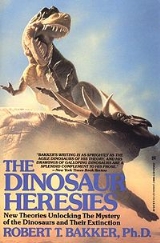
The Dinosaur Heresies
Encyclopedia
The Dinosaur Heresies: New Theories Unlocking the Mystery of the Dinosaurs and Their Extinction was a 1986 book published by Robert T. Bakker
, a prominent paleontologist.
The book sums up the extant evidence which indicates that dinosaurs, rather than being cold-blooded
and wholly lizard-like, were in fact warm-blooded
, agile creatures more similar to modern birds than to lizards or other reptiles. Although controversial on publication in 1986, the passage of time has proven Bakker correct in many respects, and much of Dinosaur Heresies now represents the prevalent view in paleontological circles (although other parts have been outdated by more current research).
The main arguments used to show that dinosaurs were warm blooded are:
Robert T. Bakker
Robert T. Bakker is an American paleontologist who helped reshape modern theories about dinosaurs, particularly by adding support to the theory that some dinosaurs were endothermic...
, a prominent paleontologist.
The book sums up the extant evidence which indicates that dinosaurs, rather than being cold-blooded
Ectotherm
An ectotherm, from the Greek εκτός "outside" and θερμός "hot", refers to organisms that control body temperature through external means. As a result, organisms are dependent on environmental heat sources and have relatively low metabolic rates. For example, many reptiles regulate their body...
and wholly lizard-like, were in fact warm-blooded
Homeotherm
Homeothermy is thermoregulation that maintains a stable internal body temperature regardless of external influence. This temperature is often, though not necessarily, higher than the immediate environment...
, agile creatures more similar to modern birds than to lizards or other reptiles. Although controversial on publication in 1986, the passage of time has proven Bakker correct in many respects, and much of Dinosaur Heresies now represents the prevalent view in paleontological circles (although other parts have been outdated by more current research).
The main arguments used to show that dinosaurs were warm blooded are:
- Almost all animals that walk upright today are warm-blooded, and dinosaurs walked upright.
- The heartHeartThe heart is a myogenic muscular organ found in all animals with a circulatory system , that is responsible for pumping blood throughout the blood vessels by repeated, rhythmic contractions...
s of warm-blooded animals can pump much more effectively than the hearts of cold-bloodedEctothermAn ectotherm, from the Greek εκτός "outside" and θερμός "hot", refers to organisms that control body temperature through external means. As a result, organisms are dependent on environmental heat sources and have relatively low metabolic rates. For example, many reptiles regulate their body...
animals. Therefore, the giant BrachiosaurusBrachiosaurusBrachiosaurus is a genus of sauropod dinosaur from the Jurassic Morrison Formation of North America. It was first described by Elmer S. Riggs in 1903 from fossils found in the Grand River Canyon of western Colorado, in the United States. Riggs named the dinosaur Brachiosaurus altithorax,...
must have had the type of hearts associated with warm-blooded animals, in order to pump blood all the way up to its head. - Dinosaurs such as DeinonychusDeinonychusDeinonychus was a genus of carnivorous dromaeosaurid dinosaur. There is one described species, Deinonychus antirrhopus. This 3.4 meter long dinosaur lived during the early Cretaceous Period, about 115–108 million years ago . Fossils have been recovered from the U.S...
led a very active life, which is much more compatible with a warm-blooded animal. - Some dinosaurs lived in northern latitudes where it would be impossible for cold-blooded dinosaurs to keep warm.
- The rapid rate of speciationSpeciationSpeciation is the evolutionary process by which new biological species arise. The biologist Orator F. Cook seems to have been the first to coin the term 'speciation' for the splitting of lineages or 'cladogenesis,' as opposed to 'anagenesis' or 'phyletic evolution' occurring within lineages...
and evolutionEvolutionEvolution is any change across successive generations in the heritable characteristics of biological populations. Evolutionary processes give rise to diversity at every level of biological organisation, including species, individual organisms and molecules such as DNA and proteins.Life on Earth...
found in dinosaurs is typical of warm blooded animals and atypical of cold blooded animals. - The predator/prey ratio of predatory dinosaurs to their prey is a signature trait of warm-blooded predators rather than cold-blooded ones.
- Birds are warm-blooded. Birds evolved from dinosaurs, therefore a change to a warm-blooded metabolism must have taken place at some point; there is far more change between dinosaurs and their ancestors, the archosaurArchosaurArchosaurs are a group of diapsid amniotes whose living representatives consist of modern birds and crocodilians. This group also includes all extinct non-avian dinosaurs, many extinct crocodilian relatives, and pterosaurs. Archosauria, the archosaur clade, is a crown group that includes the most...
s, than between dinosaurs and birds. - Warm-blooded metabolisms are evolutionary advantages for top predators and large herbivores; if the dinosaurs had not been warm-blooded there should be fossil evidence showing mammals evolving to fill these ecological niches. No such evidence exists; in fact mammals by the end of the CretaceousCretaceousThe Cretaceous , derived from the Latin "creta" , usually abbreviated K for its German translation Kreide , is a geologic period and system from circa to million years ago. In the geologic timescale, the Cretaceous follows the Jurassic period and is followed by the Paleogene period of the...
had become smaller and smaller from their mammal-like-reptileSynapsidSynapsids are a group of animals that includes mammals and everything more closely related to mammals than to other living amniotes. They are easily separated from other amniotes by having an opening low in the skull roof behind each eye, leaving a bony arch beneath each, accounting for their name...
ancestors. - Dinosaurs grew rapidly, evidence for which can be found by observing cross-sections of their bones.

